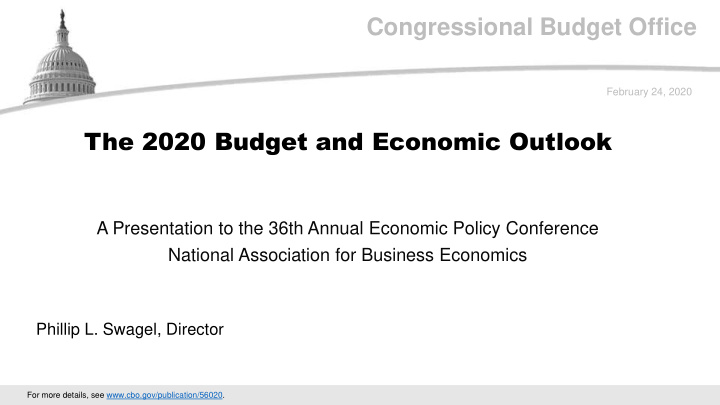



Congressional Budget Office February 24, 2020 The 2020 Budget and Economic Outlook A Presentation to the 36th Annual Economic Policy Conference National Association for Business Economics Phillip L. Swagel, Director For more details, see www.cbo.gov/publication/56020.
CBO The Economy 1
CBO We expect the unemployment rate to remain near historic lows throughout 2020 2
CBO Gains in hourly wages have been especially strong for low-wage earners since late 2016 Source: Federal Reserve Bank of Atlanta, “Wage Growth Tracker” (accessed February 11, 2020), www.frbatlanta.org/chcs/wage-growth-tracker. 3
CBO GDP is projected to grow by 2.2 percent in 2020 GDP = gross domestic product. 4
CBO Maximum sustainable output growth is projected to be faster than it was from 2008 to 2019 and slower than it was in earlier years 5
CBO We expect strong labor and product markets to contribute to faster inflation in 2020 PCE = personal consumption expenditures. 6
CBO In our projections, the Federal Reserve begins raising the target range for the federal funds rate to ease inflationary pressures 7
CBO We expect other interest rates to rise, following a path similar to that of the federal funds rate 8
CBO The Budget 9
CBO We project a cumulative federal budget deficit of $12.4 trillion from 2020 to 2029 When October 1 (the first day of the fiscal year) falls on a weekend, certain payments that would have ordinarily been made on that day are instead made at the end of September and thus are shifted into the previous fiscal year. All projections presented here have been adjusted to exclude the effects of those timing shifts. 10
CBO The gap between spending and revenues grows in our projections When October 1 (the first day of the fiscal year) falls on a weekend, certain payments that would have ordinarily been made on that day are instead made at the end of September and thus are shifted into the previous fiscal year. All projections presented here have been adjusted to exclude the effects of those timing shifts. 11
CBO Total revenues as a share of GDP are projected to rise, largely because of increasing receipts from individual income taxes * = between zero and 0.05 percentage points. 12
CBO Much of the growth of revenues in our projections stems from the expiration of tax provisions 13
CBO Since last August, we have reduced our projections of corporate income tax receipts during the 2020 – 2029 period by $127 billion The largest of those revisions are related to: Certain provisions of the 2017 tax act related to international business activities A onetime tax that the act imposed on the existing foreign earnings of U.S. corporations A rule in the act about research and experimentation expenditures New information about corporate profits during the 2016 – 2018 period See Congressional Budget Office, “Recent Changes in CBO’s Projections of Corporate Income Tax Revenues,” CBO Blog (February 7, 2020), www.cbo.gov/publication/56121. 14
CBO Increases in projected outlays stem from growth in mandatory spending and in net interest costs 15
CBO Social Security and Medicare are projected to contribute the most to growth in mandatory spending a. Consists of outlays for Medicare (net of premiums and other offsetting receipts), Medicaid, the Children’s Health Insuranc e Program, premium tax credits, and related spending. 16
CBO Spending and taxes in 2030 are projected to be very different from what they were 50 years ago When October 1 (the first day of the fiscal year) falls on a weekend, certain payments that would have ordinarily been made on that day are instead made at the end of September and thus are shifted into the previous fiscal year. That happened in 1994 and 1995, so values for 1995 have been adjusted to exclude the effects of those timing shifts. 17
CBO By 2050, debt is projected to equal 180 percent of GDP — far higher than it has ever been 18
CBO We post our projections and other data on our website See www.cbo.gov/about/products/budget-economic-data. 19
Recommend
More recommend